Belgrade Nikola Tesla Airport
| Belgrade Nikola Tesla Airport Аеродром Никола Тесла Београд Aerodrom Nikola Tesla Beograd | |||||||||||
|---|---|---|---|---|---|---|---|---|---|---|---|
.gif) | |||||||||||
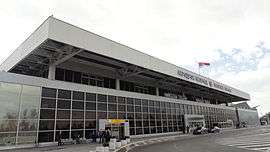 | |||||||||||
| IATA: BEG – ICAO: LYBE | |||||||||||
| Summary | |||||||||||
| Airport type | International | ||||||||||
| Owner | Government of Serbia | ||||||||||
| Operator | Aerodrom Nikola Tesla a.d.[1] | ||||||||||
| Serves | Belgrade, Serbia | ||||||||||
| Location | Belgrade | ||||||||||
| Hub for | Air Serbia | ||||||||||
| Focus city for | Wizz Air | ||||||||||
| Elevation AMSL | 336 ft / 102 m | ||||||||||
| Coordinates | 44°49′10″N 20°18′25″E / 44.81944°N 20.30694°ECoordinates: 44°49′10″N 20°18′25″E / 44.81944°N 20.30694°E | ||||||||||
| Website | beg.aero | ||||||||||
| Map | |||||||||||
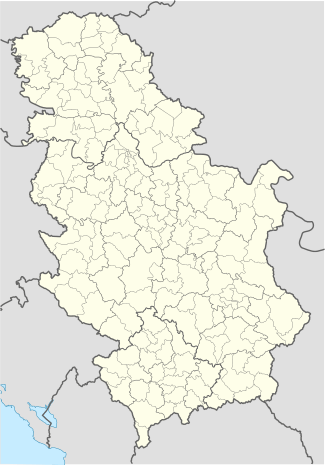 BEG Location within Serbia | |||||||||||
| Runways | |||||||||||
| |||||||||||
| Statistics (2015) | |||||||||||
| |||||||||||
Native name | Аеродром Никола Тесла а.д. |
|---|---|
| Public limited company | |
| Traded as | BELEX: AERO |
| Industry | Airport operations |
| Founded | 13 March 1992 (Belgrade, Serbia, Serbia and Montenegro) |
| Headquarters | Belgrade, Serbia |
Key people |
Saša Vlaisavljević (General director) |
| Revenue |
|
|
| |
| Total assets |
|
| Total equity |
|
| Owner |
Government of Serbia (83.15%) Others |
Number of employees | 468[4] |
| Website |
www |
Belgrade Nikola Tesla Airport (Serbian: Аеродром Никола Тесла Београд / Aerodrom Nikola Tesla Beograd) (IATA: BEG, ICAO: LYBE), is an international airport serving Belgrade, Serbia. Previously known as Belgrade Airport (Serbian: Аеродром Београд / Aerodrom Beograd) or Surčin Airport (Serbian: Аеродром Сурчин / Aerodrom Surčin), it was renamed in 2006 in honor of scientist and inventor Nikola Tesla. It is the busiest airport in Serbia.
The airport is situated 18 km (11 mi) west of downtown Belgrade near the town of Surčin, surrounded by Srem's fertile lowlands. In 2008 the airport installed ILS CAT IIIb equipment to allow aircraft to land and depart in the heaviest of fog which in past years led to numerous flight diversions mostly in late December and early January.[5]
The flag carrier and largest airline of Serbia, Air Serbia (formerly Jat Airways), uses Belgrade Nikola Tesla as their hub. It is also one of the operating bases for low cost airline Wizz Air. The air taxi services Air Pink, Jat Airways AVIO taxi and Prince Aviation also call the airport their home. The airport is operated by the Public enterprise "Aerodrom Nikola Tesla Beograd". The airport recorded a net profit of RSD 1.4 billion for the first three quarters of 2014.[6] In 2014, Belgrade Nikola Tesla Airport was the second fastest-growing major airport in Europe.[7]
History
First airfields in Belgrade
The first airfield in Belgrade was inaugurated in 1910 in the neighbourhood of Banjica and was initially used by aviation pioneers such as Simon, Maslenikov, Vidmar and Čermak. Two years later a wooden hangar was built for the Serbian Air Force, which was at the time engaged in the First Balkan War against Turkey. In 1914, the Banjica airfield was the base for the Serbian Air Force squadron and the Balloon Company. After the end of the First World War, the Banjica airfield was used for airmail traffic and included the routes Novi Sad–Belgrade–Niš–Skoplje and Belgrade–Sarajevo–Mostar.[8]
In 1911 another airfield was inaugurated in Belgrade, in the lower city of the Kalemegdan fortress on the location of today's Belgrade Planetarium.[8]
Pančevo airport
An airport in the outskirts of Pančevo, a town located northeast of Belgrade, began its operations in 1923 when CFRNA inaugurated the international route Paris–Istanbul which was flown via Belgrade. The same year airmail service began operating from the airport. The Pančevo airport was also used by the Royal Yugoslav Air Force academy. After the World War II the airport was used by the Yugoslav Air Force before it became the airfield of the Utva Aviation Industry after its relocation from Zemun to Pančevo.[8]
Belgrade international airport

Because of the distance from Pančevo to downtown Belgrade, which at that time required crossing the Danube, a decision was made to build a new airport which would be closer. The airport was planned to be built just across the river Sava, in a neighborhood today known as Novi Beograd. It was opened on 25 March 1927 under the official name of Belgrade International Airport (also known as Dojno polje Airport). From February 1928, the aircraft owned by the first local airline Aeroput started taking off from the new airport. The airport had four 1,100–2,900 metres (3,610–9,510 ft) long grass runways. The design for a reinforced concrete hangar that was built at the airfield was made by the Serbian scientist Milutin Milanković, better known for his theory of climate change. A modern terminal building was built in 1931, while the landing equipment for conditions of poor visibility was installed in 1936.[8]
Before World War II, Belgrade was also used as a stopover for some major air races, such as The Schlesinger African Air Race.[10]
Besides Aeroput, Air France, Deutsche Luft Hansa, KLM, Imperial Airways and airlines from Italy, Austria, Hungary, Romania and Poland also used the airport until the outbreak of the Second World War. Starting from April 1941, German occupation forces used the airport. During 1944 it was bombed by the Allies, and in October of same year the German army destroyed the remaining facilities while withdrawing from the country.[8]
The airport was rebuilt by October 1944 and until the end of the war was used by the Soviet Union and Yugoslavia as part of the Allied war effort.[8]
Civil transport by Air Force cargo planes from this airport was reinstated at the end of 1945. At the beginning of 1947 JAT Yugoslav Airlines and JUSTA took over domestic and international traffic, and from 1948 Western European airlines resumed flights to Belgrade.[8]
A constant increase in traffic and the beginning of the passenger jet era called for a significant expansion of the airport. In the meantime, a plan to build a residential and business district called Novi Beograd on the location of the airport was introduced. The officials decided therefore that a new international airport should be built near the village of Surčin to the west. The last flight to depart from the old airport was early in 1964.[11]
Construction of new airport
During the first years of the development of postwar Belgrade, construction of a modern airport became a social and economic priority. Basic studies and engineering research started in 1947 , and became part of the 1950 City General Plan. This document defined the future of air traffic and the role of Belgrade's Airport within the Yugoslav and international air network.
The new location for the airport was on the Surčin plateau, 15 km (9 mi) from Belgrade's city center.[11] Thanks to the original planners' vision, two conditions for the airport's development were fulfilled: a location was chosen which met the navigational, meteorological, construction, technical, and traffic requirements; and the special needs for the airport's long-term development were established.

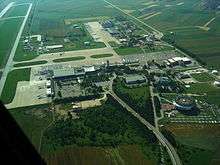
Experts from the Serbian City Planning Bureau, with the architect Nikola Dobrović at the helm, made the preliminary plans for the new airport.[11] The development and realization of the idea was taken over from 1953 onwards by the Civil Aviation Department (later Federal Department for Civil Aviation) whose experts, with engineer Miloš Lukić as team leader, finished the general plan for one runway, appropriate taxiways, and a terminal complex in 1957. Building of the new airport started in April 1958 and lasted until 28 April 1962, when it was officially opened by President Josip Broz Tito.[11]
During that period a 3,000-metre-long (1.9 mi) runway was built, with the parallel taxiway and concrete aprons for sixteen airplanes. The passenger terminal building occupied an area of 8,000 m2 (86,000 sq ft). Cargo storage spaces were also built, as well as a technical block with the air-traffic control tower and other accompanying facilities. Modern navigational equipment was installed, earning the airport the highest international classification according to the International Civil Aviation Organization.[12]
Turn of the century
The airport stagnated during the 1990s after the outbreak of the Yugoslav wars and the United Nations sanctions imposed on the Federal Republic of Yugoslavia. The sanctions also included a ban on air travel. The airport had minimal passenger movement, and many facilities were in need of attention.
With a change in government and international sentiment, normal air traffic resumed in 2001. A few years later the airport's terminal 2 underwent a major reconstruction.
The runway was upgraded to CAT IIIb in October 2005, as part of a large renovation project. CAT IIIb is the latest runway system, giving aircraft the security of landing during fog and storms.
In 2006, the airport was renamed to Belgrade Nikola Tesla Airport. Nikola Tesla was a Serbian-American inventor and scientist, generally considered one of the world's most important electrical engineers. The proposal was accepted by Aerodrom Beograd a.d., the state-owned airport authority, and received approval by the Ministry of Capital Investment, and finally the Serbian Government on 2 February 2006.[13] On 10 July 2006, to mark the 150th anniversary of the birth of Nikola Tesla, a monument was erected near Terminal 1.[14]
In August 2007, the airport management announced that within the upcoming four years, Terminal 2 gates would be expanded, as well as parking spaces for aircraft. Terminal 1 and 2 would be connected as well. The construction of the new airport control center was completed in 2010. In February 2011 Belgrade Nikola Tesla Airport shares (AERO) began trading on the Belgrade Stock Exchange (BELEX).
2012–2018 expansion
In February 2012 construction work on the modernization and expansion of Belgrade Nikola Tesla Airport began. During the summer of 2012, work was carried out on the expansion and reconstruction of the A-gate departure lounges and transit areas. Work on the C-gate area began in the summer of 2012. As a result, an extra 2,750 square metres (29,600 sq ft) were added. Air bridges at the A gates were also replaced. A new floor covering 4,900 m2 (53,000 sq ft) would be built above the current Terminal 2 building, to allow separation of arrival and departure passengers. Overall, it was announced that over €53 million would be invested into the airport by 2014.[15]
During 2012, Terminal 2 security and passport control area were also expanded. New X-ray and body-scanner machines were added to cut waiting times, with Belgrade becoming the first airport in the former Yugoslavia to use specialised shoe scanners.
In 2014, the Serbia and Montenegro Air Traffic Services Agency (SMATSA) announced that it will finance the construction of a new control tower at Belgrade Nikola Tesla Airport. The construction is planned to be completed by 2018. The current air control tower was built back in 1962.[16]
Terminals

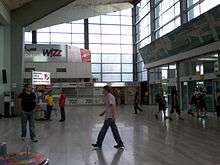

Belgrade Nikola Tesla Airport two terminals has a combined area of 33000sqm, with Terminal 2 being larger of the two, adjacent to one another terminals are connected through a hallway. T1 has restaurants and shops.[17] The airport has 27 gates (of which 16 are equipped with jetways). Future expansion of current terminals should see additional 17000sqm to be added, with terminal 2 getting additional 4-passenger boarding bridges. Capacity of the entire airport should all the planned expansion be implemented would double to around 10 million passengers per year.
Terminal 1
Terminal 1 (T1) was the original and the only terminal when the airport was opened. The terminal handled domestic flights during the time of SFR Yugoslavia. The terminal went through a major renovation in the 1980s when air bridges were added to connect passengers to the aircraft. Minor renovations were done in 2002. Since the dissolution of the Union of Serbia and Montenegro in 2006, the gates of the terminal have been used for international flights by both international and domestic carriers. From 1 January 2010, Terminal 1 is fully operational and used mostly by low-cost and charter airlines.
Terminal 2
Terminal 2 (T2) was constructed in 1979 for the airport's growing passenger numbers. After two years of reconstruction, T2 reopened in May 2006 with 33 check-in desks.[17] The terminal has a capacity of 5 million passengers.[18] The arrivals and departures areas of the terminal were completely reconstructed. The terminal contains airline offices, transfer desks and various retail shops.
In 2012, construction work on the expansion and overhaul of the C platform (T2 gates) began. The expansion caters for the growing number of passengers.[17] The airport also announced to increase parking space for some gates in order to make room for larger long-haul planes. In August 2015 the airport management announced expansion of the C concourse adjacent to Terminal 2. The extension will be built on the recently built C platform, with four jetways and four more remote positions. Work on the construction would commence in November 2015, taking nine months to complete.[19] With this feature the airport's capacity will increase from 5.5 million annual passengers to between 7.5 and 8 million.
Corporate affairs
Market data
As of 29 May 2015, Belgrade Airport Nikola Tesla has a market capitalization of 381.68 million euros.[20]
Awards
- Belgrade Nikola Tesla Airport was awarded the "Euro Annie award for the airport that has attracted the most new airlines during the 12-month period analysed (August 2010 v August 2009)[21] by anna.aero. Despite losing Olympic's service to Athens, the airport attracted 10 'new' carriers, at least compared with the previous year, making a net gain of nine carriers.
Airlines and destinations
Passenger
The following airlines operate regular scheduled and charter flights at Belgrade Nikola Tesla Airport:[22]
Cargo
The following cargo airlines serve the airport on a regular basis as of October 2016:[26]
Statistics
Traffic development
| Year | Passengers | Change | Cargo (t) | Change | Aircraft movements | Change |
|---|---|---|---|---|---|---|
| 2002 | 1,621,798 | 6,827 | 28,872 | |||
| 2003 | 1,849,148 | 6,532 | 32,484 | |||
| 2004 | 2,045,282 | 8,946 | 36,416 | |||
| 2005 | 2,032,357 | 7,728 | 37,614 | |||
| 2006 | 2,222,445 | 8,200 | 42,360 | |||
| 2007 | 2,512,890 | 7,926 | 43,448 | |||
| 2008 | 2,650,048 | 8,129 | 44,454 | |||
| 2009 | 2,384,077 | 6,690 | 40,664 | |||
| 2010 | 2,698,730 | 7,427 | 44,160 | |||
| 2011 | 3,124,633 | 8,025 | 44,923 | |||
| 2012 | 3,363,919 | 7,253 | 44,990 | |||
| 2013 | 3,543,194 | 7,679 | 46,828 | |||
| 2014 | 4,638,577 | 10,222 | 58,695 | |||
| 2015 | 4,776,110 | 13,091 | 58,513 | |||
| 2016 (1.1–31.10.) | 4,249,497 | 11,630 | 50,327 | |||
Busiest routes
Top Carriers
| Rank | Carrier | Passengers 2014 | % | Passenger % Change 2013 |
|---|---|---|---|---|
| 1 | | 2,347,923 | 50.6 | |
| 2 | | 415,590 | 9.0 | |
| 3 | | 283,867 | 6.1 | |
| 4 | | 258,841 | 5.6 | |
| 5 | | 203,518 | 4.4 | |
| 6 | Other Airlines | 1,128,754 | 24.3 | |
| Source: Belgrade Airport[2] | ||||
Services
Security
Belgrade Airport is built with only one airside hallway for both departing and arriving passengers. For that reason, security checks are located at gate entrances rather than on a central location. Passport controls are placed on two entrances and the single exit of the hallway. All passengers must pass the passport control, as there are no domestic flights. An additional security check used to exist on the hallway entrance, but it was removed in 2013 as it inconvenienced passengers and was not essential for security.[28]
In August 2007 the airport prohibited cars parking next to the airport terminal, instead they have to use the car park provided, as a result of the 2007 Glasgow International Airport attack. All parked cars in restricted zones will be towed away, and the owners will receive a fine.[29]
Lounges
Belgrade Airport offers a single business class lounge, "Business Club", for all airlines operating from the airport. "Business Club", opened in December 2011, replaced the older lounge which has been closed since. The new business lounge covers an area of 250 m2 (2,700 sq ft), and seats 30 guests.
Nikola Tesla Airport also has a VIP lounge, with separate check-in and passport control facilities- also used by general aviation customers, which was built during the 2004-2006 terminal 2 reconstruction. The lounge consists of three parts - the first part for leisure, second for television crew and press conferences and a third part is a presidential suite. The lounge has a total surface area of 500 m2 (5,400 sq ft). The lounge is also used as a press centre, upon the arrival of VIPs.
Ground transport
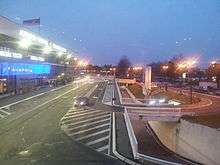
By car
Belgrade Airport is connected to the Belgrade–Šid highway (A3) via a nearby interchange. ![]()
By bus
| Service | Destination (departing from the airport) | Operator | Frequency | Trip duration |
|---|---|---|---|---|
| Line A1 | Slavija Square | Belgrade public transport system | 20 minutes | 30 minutes[30] |
| Line 72 | Zeleni Venac | GSP Belgrade Transport Company | 24 minutes | 30–40 minutes[30] |
By taxi
Licensed taxis from the airport to the city are available.
See also
- List of airlines of Serbia
- List of airports in Serbia
- List of the busiest airports in the Balkans
- Museum of Aviation, Belgrade
References
- 1 2 Belgrade Nikola Tesla Airport – Basic Company Data www.beg.aero (English) (Serbian)
- 1 2 "Official website" (in Serbian). Retrieved 11 April 2007.
- ↑ EAD Basic
- 1 2 3 4 5 "Основни подаци из годишњег финансијског извештаја за обвезника ревизије за 2013. годину". Agencija za privredne registre Srbije. Retrieved 9 May 2014.
- ↑ "Aerodrom Nikola Tesla - History". Retrieved 22 November 2014.
- ↑ Aerodrom Nikola Tesla Beograd. "Belgrade Airport Q3 2014 financial report" (PDF). Retrieved 22 November 2014.
- ↑ "Belgrade Nikola Tesla Airport among fastest growing in Europe". 13 August 2014.
- 1 2 3 4 5 6 7 Belgrade Nikola Tesla Airport. "History: International Belgrade Airport (1927)". Archived from the original on 5 October 2007. Retrieved 24 July 2007.
- ↑ "Milanković's hangar today". Retrieved 12 December 2014.
- ↑ England to Africa at The Mercury, 21 September 1936
- 1 2 3 4 Jovan Nikolić (8 May 2007). "Svi Beogradski aerodromi" (in Serbian). Glas javnosti. Retrieved 24 July 2007.
- ↑ Belgrade Nikola Tesla Airport. "History: Belgrade Surcin (1962)". Retrieved 4 April 2007.
- ↑ B92 (2 February 2006). "Aerodrom menja ime u "Nikola Tesla"" (in Serbian). Archived from the original on 13 March 2007. Retrieved 4 April 2007.
- ↑ Belgrade Nikola Tesla Airport (10 July 2006). "Na beogradskom Aerodromu otkriven spomenik Nikoli Tesli" (in Serbian). Archived from the original on 18 March 2007. Retrieved 4 April 2007.
- ↑ "Belgrade Airport overhaul in full force". exyuaviation. 2012.
- ↑ "Rovčanin: Novi kontrolni tornjevi u Beogradu i Tivtu" (in Serbian). Tanjug. 1 October 2014.
- 1 2 3 Mondo WEB Portal (14 May 2006). "Otvoren "Terminal 2" na aerodromu u Beogradu" (in Serbian). Archived from the original on 27 September 2007. Retrieved 14 May 2006.
- ↑ I.R. (15 May 2006). "Vrata za pet miliona putnika godišnje" (in Serbian). Danas. Archived from the original on 1 April 2012. Retrieved 4 April 2007.
- ↑ http://tangosix.rs/2015/04/08/prve-fotografije-novi-izgled-c-hodnika-aerodroma-nikola-tesla/
- ↑ "Pokazatelji: AERO". belex.rs (in Serbian). Retrieved 30 May 2015.
- ↑ "Serbia's Belgrade Nikola Tesla attracts most new carriers during last 12 months". anna.aero Airline News & Analysis.
the Euro annies (August 2010 v August 2009)- based on science, statistics and evidence
- 1 2 Airport Nikola Tesla Seasonal Timetable
- ↑ http://www.israirairlines.com/
- ↑ http://www.exyuaviation.com/2016/09/transavia-to-launch-flights-to-belgrade.html
- 1 2 3 4 http://www.exyuaviation.com/2016/08/wizz-air-to-announce-serbia-expansion.html
- ↑ Airport Nikola Tesla Cargo Timetable
- ↑ "Traffic Figures Archive". Nikola Tesla Airport Official Website. Retrieved 2016-05-05.
- ↑ "Samo jedna kontrola na aerodromu" [Only one control on the Airport]. RTS. 20 May 2013.
- ↑ Mondo WEB Portal (14 August 2007). "Zabranjen saobraćaj ispred zgrade aerodroma" (in Serbian). Archived from the original on 27 September 2007. Retrieved 8 August 2007.
- 1 2 Belgrade Nikola Tesla Airport. "Official website". Retrieved 26 February 2013.
External links
![]() Media related to Belgrade Nikola Tesla Airport at Wikimedia Commons
Media related to Belgrade Nikola Tesla Airport at Wikimedia Commons
